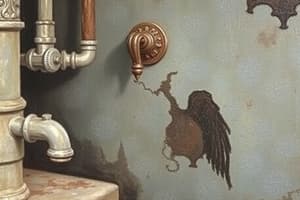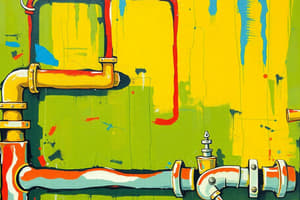Podcast
Questions and Answers
When was the Department of Public Services of the City of Manila created?
When was the Department of Public Services of the City of Manila created?
By an Act of Congress
RA 1378 was signed by President Ramon Magsaysay on January 28, 1959.
RA 1378 was signed by President Ramon Magsaysay on January 28, 1959.
True (A)
What was included in the first amendment to the National Plumbing Code on November 28, 1967?
What was included in the first amendment to the National Plumbing Code on November 28, 1967?
- New registration processes for plumbers
- Creation of a Plumbing Code Review Committee
- Introduction of new plumbing materials
- Asbestos-Cement Pipe as an approved plumbing material (correct)
Who was the first Chief of the Division of Plumbing Construction and Inspection?
Who was the first Chief of the Division of Plumbing Construction and Inspection?
The organization ___ was registered with the SEC in 1935.
The organization ___ was registered with the SEC in 1935.
Filipino plumbers were responsible for maintaining plumbing systems starting from the 18th century.
Filipino plumbers were responsible for maintaining plumbing systems starting from the 18th century.
What major change in plumbing occurred during the American occupation in the 20th century?
What major change in plumbing occurred during the American occupation in the 20th century?
Who chaired the Plumbing Code Review Committee during the update in 1996?
Who chaired the Plumbing Code Review Committee during the update in 1996?
The first session of the third Congress of the Republic of the Philippines approved House Bill No. ___ on June 18, 1955.
The first session of the third Congress of the Republic of the Philippines approved House Bill No. ___ on June 18, 1955.
Flashcards are hidden until you start studying
Study Notes
History of Plumbing in the Philippines
- Plumbing in the Philippines dates back to the 17th century during the Spanish occupation.
- The Spanish established Intramuros, a walled city designed as a model community, which included plumbing infrastructure.
- Filipino plumbers emerged during the 18th and 19th centuries, responsible for repairing and maintaining plumbing in towns, churches, and government buildings.
- The arrival of American engineers, teachers, doctors, and evangelists in the 20th century significantly accelerated plumbing development.
- This period saw a focus on health and hygiene, due to frequent epidemics, and proper waste disposal became a priority.
- Governor General Harrison issued instructions for municipalities to implement proper waste disposal.
The National Master Plumbers Association of the Philippines (NAMPAP)
- The National Master Plumbers Association of the Philippines (NAMPAP) was founded in 1935.
- NAMPAP was instrumental in advocating for the establishment of the National Plumbing Code.
- The organization was also key in creating the National Waterworks and Sewerage Authority (NAWASA).
City Ordinance 2411
- The Department of Public Services of the City of Manila was created in 1954 by an Act of Congress.
- City Ordinance 2411, which was approved by the Third Congress of the Republic of the Philippines in 1955, was signed into law as RA 1378 by President Ramon Magsaysay.
- This legislation officially codified the plumbing profession and regulated plumbing practices.
Development of the National Plumbing Code
- In 1959, the National Plumbing Code, prepared by NAMPAP, was promulgated by Malacañang.
- The first amendment to the National Plumbing Code, approved in 1967, included asbestos-cement pipe as an approved plumbing material.
- The Building Code of the Philippines, encompassing the National Plumbing Code of 1959, was passed in 1969.
Creation of a Curriculum for Plumbing Engineering
- Between 1966 and 1969, the Board of Examiners for Master Plumbers and NAMPAP developed a curriculum for plumbing engineering.
- This curriculum was approved by the Department of Education and first introduced at Feati University.
The Revised National Plumbing Code of the Philippines (RNPCP)
- NAMPAP created a Plumbing Code Committee in 1994 to revise the National Plumbing Code.
- NAMPAP President Jaime M. Cabase led the effort to update the code in 1996.
- The draft code was submitted to the Board of Master Plumbers in October 1999.
- The PRC Chairman, Hermogenes P. Pobre, adopted the Revised Plumbing Code of 1999.
- The revised code was approved by President Joseph Ejercito Estrada on December 21, 1999.
- The RNPCP was considered modern due to its incorporation of contemporary plumbing materials and practices.
Key Personnel
- Fortunato H. Amosco: Chairman of the Board of Master Plumbers in 1999.
- Aida Emelyn B. Luz: Member of the Board of Master Plumbers in 1999.
- Jesus K. Pacheco: Member of the Board of Master Plumbers in 1999.
- Carlos G. Amelor: Secretary of the Professional Regulatory Boards in 1999.
- Hermogenes P. Pobre: Chairman of the Professional Regulation Commission (PRC) in 1999.
- Alfonso G. Abad: Associate Commissioner of the PRC in 1999.
- Avelina De La Rea-Tan: Associate Commissioner of the PRC in 1999.
- Joseph Ejercito Estrada: President of the Philippines in 1999.
- John Hass: First Chief of the Division of Plumbing Construction and Inspection.
Studying That Suits You
Use AI to generate personalized quizzes and flashcards to suit your learning preferences.




